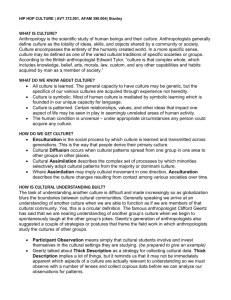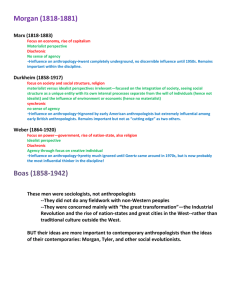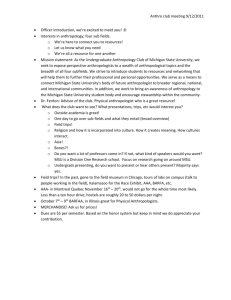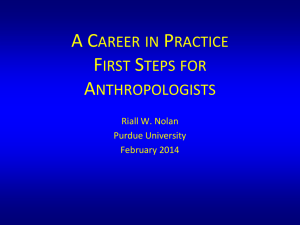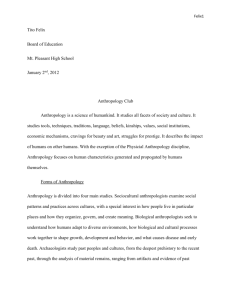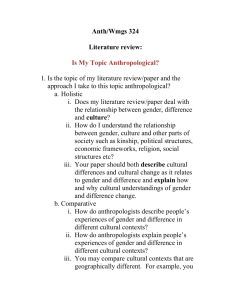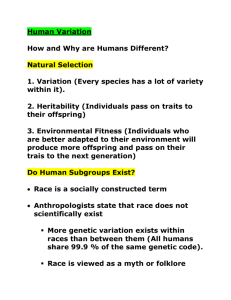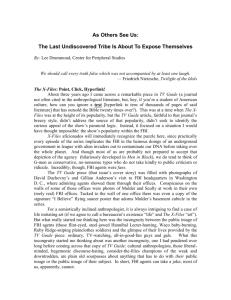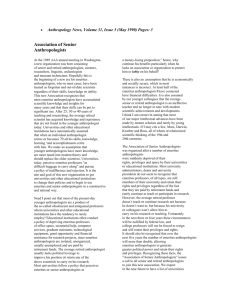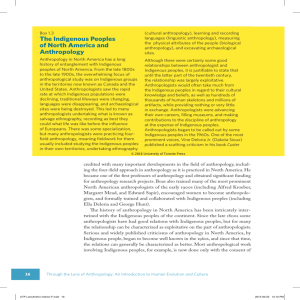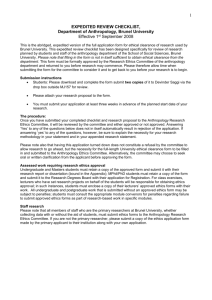Chapter 13
advertisement
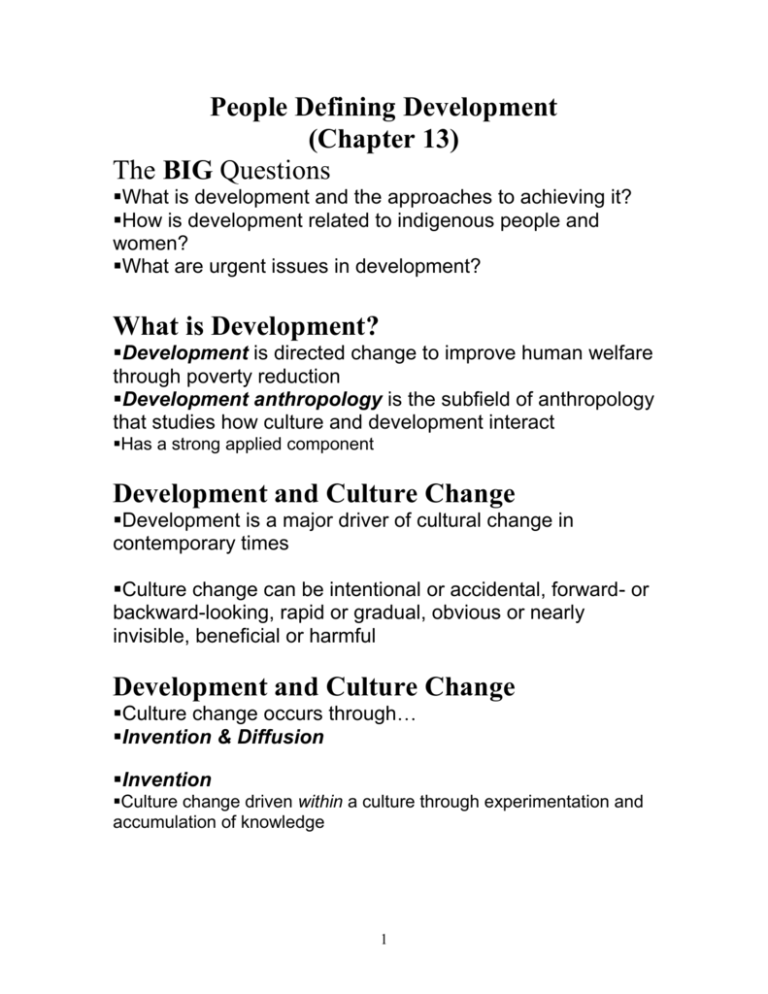
People Defining Development (Chapter 13) The BIG Questions What is development and the approaches to achieving it? How is development related to indigenous people and women? What are urgent issues in development? What is Development? Development is directed change to improve human welfare through poverty reduction Development anthropology is the subfield of anthropology that studies how culture and development interact Has a strong applied component Development and Culture Change Development is a major driver of cultural change in contemporary times Culture change can be intentional or accidental, forward- or backward-looking, rapid or gradual, obvious or nearly invisible, beneficial or harmful Development and Culture Change Culture change occurs through… Invention & Diffusion Invention Culture change driven within a culture through experimentation and accumulation of knowledge 1 Diffusion – culture change driven by cultural contact; the spread of culture through contact Can occur… Between cultures of roughly equal power A more powerful culture appropriating aspects of a less powerful culture Transfer from a dominant culture to a less powerful one – through force, education, “marketing” Acculturation – Form of cultural change in which a minority culture becomes more like the dominant culture Assimilation – Form of culture change in which a culture is thoroughly acculturated and is no longer distinguishable as having a separate identity Models of Development No single view of how to achieve development exists They differ in terms of… The goals of development The process of development – how development is accomplished How development is measured Attention to environmental and financial sustainability Models of Development Five major models… Modernization Growth-oriented development Distributional development Human development Sustainable development Some of the models overlap and are not mutually exclusive Models of Development Modernization 2 Modernization is a form of change marked by economic growth through industrialization and market expansion Western model – belief that other cultures can develop in the same way that the West did Goals: Industrialization, technological progress Process: Belief that science and technology are the pathways to progress; material progress will lead to individual betterment Problems: Little regard for the environment, brings about social inequality, trying to assimilate cultures to a Western way of thinking Growth-Oriented Development Is similar to modernization in its goals Key emphasis on economic growth Belief that economic growth will trickle-down, leading to improved human welfare among the less well-off Goals: economic growth, industrialization, technological progress Measurement of development: Rate of growth of the economy, gross domestic product (GDP) Process: Structural adjustment 1. Increasing economic productivity and trade through modernized agriculture and manufacturing and participation in world markets. 2. Reducing government expenditures on public services such as schools and health in order to reduce debt and reallocate resources to increase productivity. Problems: Will the wealth trickle-down? Or will the rich get richer and the poor get poorer? Green revolution – rich got richer and the poor got poorer Distributional Development Goal: Emphasizes social equality in benefits, especially in terms of increased income, literacy, and health Process: 3 Rejects the trickle-down process as ineffective in reaching less well- off people Opposes structural adjustment policies because structural adjustment undermines the welfare of the poor by removing the few entitlements they had in the form of services Advocates need for benevolent government to ensure equitable access of resources for the poor to provide for their own needs – government investment in schools, health care, land redistribution, etc. Measurement of development: Health status, literacy, social equality Problems: May have difficulty implementing “Socialism” and “big government” are seen as having negative connotations among some areas of the West Kerala, a state in South India, has followed a distributive path to development and, though the “poorest” state in India, it has the highest social indicators in health and education Human Development Based on the belief that people are the real wealth of nations Investments in improving human welfare will lead to economic development, not vice versa Goal: Invest in human welfare rather than economic growth Process: Invest in health, education, personal security, and safety (may involve redistribution) Measurement of development: Human development index (HDI) – measure of life expectancy, literacy, education, standard of living, and GDP per capita (strives to measure overall well-being, not just economic well-being) Problems: well-being is subjective – e.g. measuring quality of life, human development, and human welfare are tricky Gross International Happiness (GIH) http://www.grossinternationalhappiness.org/index.html 4 Sustainable Development Sustainable development refers to forms of improvement that do not destroy nonrenewable resources and are financially supportable over time Based on the belief that the economic growth of wealthy countries has been and still is costly in terms of the natural environment and people whose lives depend on these ecosystems Goal: Non-environmentally destructive development Measurement of development: environmental indicators and other social and economic indicators Institutional Approaches to Development There are a wide variety of institutions, organizations, and specialists involved in development policy making, programs, and projects Cultural anthropologists examine the organizations involved in international development Behavior within the institutions Institutional discourse Social interactions with the “client population” Institutional Approaches to Development Large-scale development institutions Multilateral institutions – those that include several countries as “donor” members United Nations World Bank Founded in 1944 Dedicated to promoting the concept of economic growth worldwide Is supported by contributions from over 150 member countries – economic superpowers dominate it 5 Main strategy is to promote international investment through loans Most loans support large infrastructure projects such as roads and dams Most loans charge interest and are tied to certain conditions Large-scale development institutions Bilateral institutions – those that involve only two countries: a “donor” and a “recipient” United States Agency for International Development (USAID) Canadian International Development Agency (CIDA) Britain’s Department for International Development (DfID) Differ in amount of grants versus loans, countries to which they lend to, etc. depending on each “donor” country’s interests and political goals Small-scale organizations Grassroots approach – locally initiated projects More likely to be culturally appropriate, supported through local participation, and successful Often utilize social capital – intangible resources of social ties, trust, and cooperation Often can use social capital to provide basic social and economic needs May be faith-based organizations The Development Project Development institutions, whether they are large or small, implement their goals through the development project The development project is a set of activities designed to put development policies into action The Project Cycle All development projects have a project cycle, or the full process of a project from initial planning to completion 6 The project cycle includes 5 basic steps from beginning to end The Development Project Cycle History of Anthropologists and the Project Cycle Most individuals that work in large-scale development institutions are economists Since the 1970s applied anthropologists have been involved in development projects Anthropologists were first hired to be project evaluations Found a variety of problems with development projects Problems with Development Projects The project was inappropriate for the cultural and environmental context 7 The target group, such as the poor and women, had not been reached, but instead project benefits had gone to some other group The intended beneficiaries were actually worse off after the project than before it Why these problems? Poor project design Projects designed by people-distant and culturally uninformed bureaucrats, usually Western economists who lived in cities far from the project site with no firsthand experience of the lives of the target population Lack of a sociocultural fit Sociocultural fit is taking the local culture into account in project design e.g. giving milk to a community that is lactose intolerant Tree project in Haiti “Experts” applied a universal formula (“one size fits all”) to all situations Development aggression – the imposition of development projects and policies without the free, prior, and informed consent of the affected people Some scholars argue that many development projects are a form of neocolonialism Anthropologists and the Project Cycle Today Today anthropologists are involved in earlier aspects of the project cycle as well Recognition among development institutions for the people-close, culturally informed perspective that anthropologists begin Anthropologists may engage in traditional development anthropology (TDA) 8 When an anthropologist takes on a role of helping to make development policies and programs work better Anthropologist asks: What can I do to make this project successful? Or anthropologists may engage in critical development anthropology (CDA) When an anthropologist takes on a critical-thinking role Anthropologist asks: Is this a good project from the perspective of the local people and their environment? Anthropologists may be considered a bit of a nuisance because their involvement may slow the process of implementing projects But hopefully the tradeoff is a more successful project! Social Impact Assessment Social impact assessments are studies that gauge the potential social costs and benefits of particular innovations before change is undertaken Anthropologists are often involved in these assessments The studies may allow communities that are confronting the adoption of new technology the chance to weigh evidence on the pros and cons and make an informed judgment Development and Minority Groups Indigenous people and women are often the ones most negatively affected by development projects Indigenous People & Development Example: Native Peoples of Walpole Island, Canada, fought to control industrial waste that was polluting their water and land 9 Women and Development Have lost political power and rights to property e.g. decline of matrilineality Increased inequality in genders by giving men greater access to new sources of income Have undergone “domestication” due to development projects which focus on infant feeding practices, child care, and family planning Their lives have been more focused on the domestic domain and more removed from the public domain Male bias in development and the exclusion of women has led to some development projects to fail Urgent Issues and New Directions in Development Designing more people centered projects is a priority Redefining development projects as life projects A life project is local people’s vision of the direction they want to take in life, informed by their knowledge, history, and context, and how to achieve that vision Viewing the protection of cultural rights as a human right Making sure development doesn’t destroy culture and a culture’s environment should be a priority Great in theory, but in practice in our increasingly globalized world cultural practices and positions of two or more cultures may conflict Viewing cultural heritage as a way to development Promoting cultural heritage, through tourism for example, can be a double-edged sword, though Tourism can preserve and protect cultural heritage (e.g. preserving indigenous arts) But tourism can also damage and destroy culture and the environment (e.g. through roads, hotels) Promoting cultural intellectual property rights Can help people gain a share of profits from intellectual property But can also be difficult to defend and enforce 10 Cultural Anthropology of the Future Cultural anthropologists work with and for local people To secure human rights and prevent human rights abuses To improve their lives through appropriate development projects and policies To foster cultural diversity, understanding, and survival throughout the world The BIG Questions Revisited What is development and the approaches to achieving it? How is development related to indigenous people and women? What are urgent issues in development? 11
